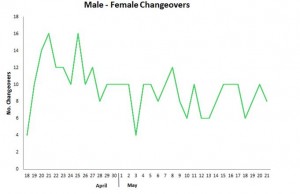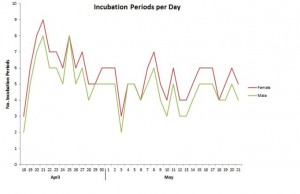Osprey Diary Friday 24th May
What a glorious spring day here at Loch of the Lowes- unbroken sunshine has brought out so many more wildflowers and early butterflies today- and a mass hatching in insects on the loch, ideal food for the hundreds of sandmartins and dozens of swifts. Today we hosted two classes from local Pitlochry High school who helped us do some biodiversity monitoring on the reserve- good science in action experience for them- thanks folks!
Of course excitement here is really building as we await the hatching of our osprey eggs– the first is ‘due’ tomorrow. Today we have twice seen one of the eggs ‘wobble’ a little by itself- a good sign someone is alive in there, which has buoyed all our hopes.
Ainoa our Species Protection Officer, has been doing some very impressive number crunching on her nightwatch shifts, and has come up with some very interesting statistics on our osprey’s incubation period so far this year.
It seems that during April the female and male swapped incubation duties an average of 11 times per day, but the time they incubated for each was therefore shorter. In May so far, there have only been 9 swaps per day, and each bird has taken longer on the nest each time. This might account for our male getting ‘bored’ and restless and giving up on his shifts.
These graphs show the pattern emerging quite clearly.

Q: Are you planning to satellite tag all of Lady’s chicks that hatch and survive, even if it’s two or three or four??
A: Thanks to the kind donations of so many members, supporters and fans of migration science research, we have enough money this year to satellite tag two osprey chicks. If we are lucky enough to have two healthy chicks at this nest, we will do both as we really want to be able to follow our veteran females ‘genetic legacy’ in her chicks. If there are more than two chicks, we will choose the strongest and fittest to carry the tags. Roy Dennis has again kindly agreed to do the tagging for us (in cooperation with Keith Brockie from the Tayside Raptor Study group) and these two are foremost experts in their field.
Ranger Emma
Help protect Scotland’s wildlife
Our work to save Scotland’s wildlife is made possible thanks to the generosity of our members and supporters.
Join today from just £3 a month to help protect the species you love.
Preface
What a glorious spring day here at Loch of the Lowes- unbroken sunshine has brought out so many more wildflowers and early butterflies today- and a mass hatching in insects …

